A 2026 BGES Civil War Field University Program
with Wade Sokolosky
March 26–29, 2026; from Smithfield, NC
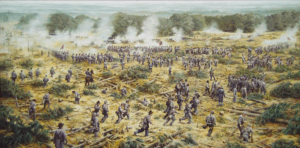
Civil War events in Virginia have long overshadowed Maj. Gen. William Tecumseh Sherman’s 1865 push through the Carolinas. After his largely unopposed March to the Sea culminated in December 1864 with the capture of Savannah, Georgia, Sherman turned north to unite with Federal forces in Virginia and crush Robert E. Lee. Resistance in the Carolinas, however, was not yet at an end. As Sherman rampaged through South Carolina, Confederate Gen. Joseph E. Johnston, recalled to command from semi-retirement, gathered forces to resist him in its neighboring state. In a furious 14-day span later known as “Two Weeks of Fury,” Johnston’s outnumbered army opened and fought four desperate battles, three of them on the offensive.
Noted 1865 Carolinas Campaign historian and author Wade Sokolosky will interpret the operations and the sacrifices at the battles of Wise’s Forks, Monroe’s Crossroads, Averasboro, and Bentonville—the Tar Heel State’s largest engagement in the war.
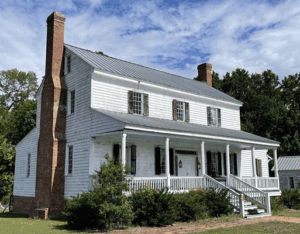


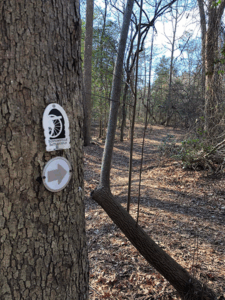
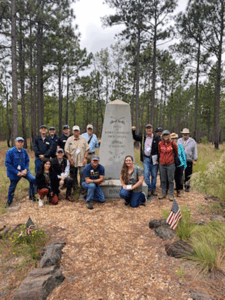
Itinerary
Thursday, March 26, 2026 – Orientation (6–7 p.m.)
Meet at the Fairfield Inn Smithfield, NC, for a meet-and-greet with your guide, Col. Wade Sokolosky, and fellow participants. Pick up nametags and handout packets, followed by a brief discussion of Sherman’s 1865 Carolinas Campaign and a preview of our subsequent days of touring.
Dinner is on your own.
Friday, March 27, 2026 (8 a.m.–5 p.m.)
Visit Kinston to tour the four-day Battle of Wise’s Forks. Highlights include exploring some of North Carolina’s best-preserved Civil War earthworks, such as the Southwest Creek Line, where the Confederates defended Kinston against possible advances by Federals from occupied New Bern. Key battlefield sights include the capture of an entire U.S. Army brigade by Confederate forces led by Gens. D. H. Hill and Robert F. Hoke, and Gen. Braxton Bragg’s failed attempts to flank Gen. Jacob D. Cox’s heavily fortified position at Wise’s Forks.
After lunch, we will tour the CSS Neuse State Historic Site to see the well-preserved remains of this ironclad. We will then follow up our exploration of the original Neuse with a guided tour of the CSS Neuse II, a full-scale replica of the ironclad.
Lunch is included, but dinner is on your own.
Saturday, March 28, 2026 (8 a.m.–5 p.m.)
Our day begins at Monroe’s Crossroads, where Confederate generals Wade Hampton and Joseph Wheeler launched a fierce dawn attack on Sherman’s cavalry camp, commanded by Gen. Judson Kilpatrick. We then proceed along the march route to Fayetteville to see the remains of the Confederate Arsenal and Armory, destroyed by Sherman’s 1st Michigan Mechanics & Engineers during their brief stay. Afterward, we will leave the arsenal and make a quick stop at the historic Market House, where Confederate Gen. Wade Hampton, with a small cavalry force, repelled the initial Federal advance with a mounted fight in the town. Finally, we cross the Cape Fear River and follow the Confederate retreat route toward Averasboro.
At Averasboro, we will examine the classic defense in depth, planned and executed by Gen. William Hardee, which successfully halted the forces of Gen. Henry Slocum’s Left Wing for two days.
The highlight of the visit is lunch inside the historic Oak Grove Plantation, one of three wartime plantation homes that still stand today. Oak Grove served as a U.S. Army field hospital during the battle. If open (subject to available volunteers), we also plan to visit the Averasboro Battlefield Museum.
Lunch is provided, but dinner is on your own.
Sunday, March 29, 2026 (8 a.m.–5 p.m.)
Our final day is devoted to Bentonville Battlefield State Historic Site, where we tour the three-day battle that witnessed the heaviest fighting of the 1865 Carolinas Campaign. Here, Confederate Gen. Joseph Johnston’s Army of the South confronted elements of both wings of Sherman’s Military Division of the Mississippi in what became the largest battle ever fought in North Carolina.
Lunch is provided, but dinner is on your own.
Bentonville, March 19, 1865 (Day One of the Battle): We begin by visiting what are believed to be the last trenches constructed by the Confederate Army of Tennessee, and then walk in the footsteps of the men who made the “Last Grand Charge of the Army of Tennessee.” We will examine the sector known as the “Bull Pen,” sacred ground where Gen. Jefferson C. Davis’s division of the 14th Corps repelled repeated Confederate attacks from multiple directions. Our final stop of the day is the Morris Farm, where the 20th Corps, supported by massed artillery, successfully beat back five successive Confederate charges, thus forcing the culmination of the day’s fighting.
Bentonville, March 20, 1865 (Day Two of the Battle): We then turn our focus on the consolidation of Sherman’s two wings and the reconfiguration of Johnston’s defensive lines. With his army battered but unbroken, Johnston now sought to lure Sherman into an attack on his fortified position. Highlights include visiting the area where Gens. Oliver O. Howard and Francis Blair were nearly captured, and walking additional stretches of Confederate earthworks.
Bentonville, March 21, 1865 (Day Three of the Battle): Our final segment examines the controversial reconnaissance in force by Gen. Joseph Mower, one of Sherman’s most aggressive division commanders. Mower’s division-sized force overran Johnston’s headquarters, and he would have possibly blocked the Confederates’ only retreat route if not for Sherman’s decision not to reinforce his aggressive division commander. It was during the Confederate counterattack, led by General Hardee, that his 16-year-old son, Willie, was mortally wounded while participating in a cavalry charge carried out by “Terry Texas Rangers.”
Notes about the tour:
1) Although designed to follow the four battles chronologically, the tour’s sequence may alter pending U.S. Army authorization to visit Monroe’s Crossroads (located within a military reservation). A valid U.S. government-issued ID card or state driver’s license is required for access. No ID, no base access.
2) Additionally, Monroe’s Crossroads lies within active training areas, with drop zones to the north and artillery impact areas to the south. Military priorities may trigger last-minute cancellations even after clearance. If access is withdrawn, we will adjust the itinerary.
3) Portions of Bentonville and Wise’s Forks are not vehicle-accessible. Please wear comfortable footwear and seasonal clothing; walking or hiking sticks are encouraged.
About the Faculty
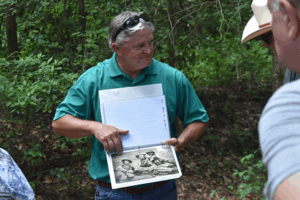
Colonel Wade Sokolosky (Ret.), a native of Beaufort, North Carolina, is a graduate of East Carolina University and a 25-year veteran of the U.S. Army. He is one of North Carolina’s leading experts on the 1865 Carolinas Campaign. Wade has lectured nationwide, speaking to roundtables, various societies and organizations, and at historic sites. He is the author of North Carolina’s Confederate Hospitals, 1861-1865, volumes 1 and 2. Wade is also the co-author (with Mark A. Smith) of “To Prepare for Sherman’s Coming”: The Battle of Wise’s Forks, March 1865; and “No Such Army Since the Days of Julius Caesar”: Sherman’s Carolinas Campaign from Fayetteville to Averasboro. He is the compiler of “Final Roll Call,” Confederate Losses during the 1865 Carolinas Campaign, volume 1 (North Carolina). Volume 2, covering soldiers from Alabama, Arkansas, and Florida, was released in March 2025.
Wade received the UDC 2024 Jefferson Davis Historical Gold Medal for his outstanding contributions to publishing and lecturing on Confederate history. Additionally, the Raleigh Civil War Round Table’s 2017 T. Harry Gatton Award honored his significant efforts to study, preserve, and share North Carolina’s Civil War heritage.
Wade is the Executive Director for the nonprofit Blue & Gray Education Society, which is dedicated to the objective study of the origins and impact of the American Civil War and related events. Additionally, he serves as the Vice President of the Friends of Bentonville Battlefield and is a member of the Brunswick County Civil War Round Table Advisory Council. Wade lives in Beaufort, North Carolina.
Hotel Information
This program will be headquartered at the Fairfield Inn Smithfield, 809 Venture Drive, Smithfield, NC 27577 (919-938-0050). The BGES special hotel rate is $124 plus tax, with a rate cut-off date of February 26, 2026. When you call the hotel, be sure to tell them that you are booking your room with the group “Blue and Gray Education” to get the special rate.
Book your stay online with the Blue and Gray Education special rate already applied:
Fairfield by Marriott Inn & Suites Smithfield Selma/I-95 for 124.00 USD per night – Last Day to Book: Thursday, February 26, 2026
Book your group rate for Blue & Gray Education
Transportation
The servicing airport is Raliegh-Durham, NC (RDU), which is 48 miles from the Fairfield Inn, Smithfield, NC. It will likely require a rental car to reach the hotel.
Recommended Reading
You will receive maps and handouts that will meet your onsite requirements. The following books are suggested to enhance your readiness for the program.
- Mark L. Bradley. Last Stand in the Carolinas: The Battle of Bentonville. El Dorado Hills, CA: Savas Publishing, 1996. ISBN: 978-1882810024.
- Wade Sokolosky and Mark A. Smith. “To Prepare for Sherman’s Coming” The Battle of Wise’s Forks, March 1865. El Dorado Hills, CA: Savas Beatie, 2023. ISBN: 978-1611216790.
- Mark A. Smith and Wade Sokolosky. “No Such Army Since the Days of Julius Caesar” Sherman’s Carolinas Campaign from Fayetteville to Averasboro. El Dorado Hills, CA:: Savas Beatie, 2025. ISBN: 978-1611216639.
- Eric Wittenberg. The Battle of Monroe’s Crossroads: The Civil War’s Final Campaign. El Dorado Hills, CA: Savas Beatie, 2006. ISBN: 978-1932714173.
Tour Pricing
Current BGES member $825 (one-time payment, no deposit)
Non-BGES member $875 (one-time payment, no deposit)
Deposit to reserve spot: $150
Annual membership fee: $75
Registration
To register by mail or fax, download: Printable Registration Form
Questions? Need more information? Please Contact Us
